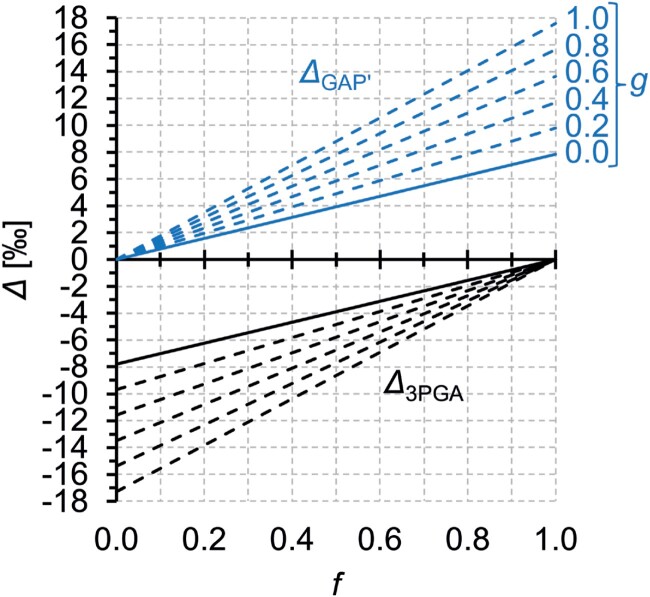Fig. 4.
Modelled 13C discrimination, Δ, by leaf-cytosolic glyceraldehyde-3-phosphate dehydrogenases (GAPDHs) at carbon positions corresponding to tree-ring glucose C-4. In this model, cytosolic glyceraldehyde 3-phosphate (GAP) has two fates: (i) glycolytic 3-phosphoglycerate (3PGA) and downstream metabolism, and (ii) fructose 1,6-bisphosphate (FBP) and downstream metabolism including the biosynthesis of tree-ring glucose (Fig. 1). Commitment of GAP to 3PGA versus FBP metabolism is given on the abscissa as f (e.g. f=0: all GAP enters FBP metabolism, f=1: all GAP enters 3PGA metabolism). Leaf cytosol contains two entirely unrelated GAPDHs (no sequence homology). While the irreversible non-phosphorylating (np-) GAPDH can catalyse GAP to 3PGA forward reactions only, the reversible phosphorylating (p-) GAPDH together with phosphoglycerate kinase can catalyse both the forward and reverse reaction. The contribution of np- versus p-GAPDH to catalysing the GAP to 3PGA forward reaction is given as g (e.g. g=0, forward reaction catalysed exclusively by p-GAPDH; g=1, forward reaction catalysed exclusively by np-GAPDH). GAP entering the system has Δ=0. Blue lines, discrimination in GAP committed to FBP metabolism denoted Δ GAP′; black lines, discrimination in 3PGA denoted Δ 3PGA; solid lines, discrimination without activity of np-GAPDH (g=0); dashed lines, discrimination when np-GAPDH catalyses fractions of the GAP to 3PGA forward reaction. p-GAPDH has a kinetic isotope effect of 1.0097 and an equilibrium isotope effect of 0.992 in vitro (Table 1; Canellas and Cleland, 1991). In contrast, the 13C isotope effect of np-GAPDH is unknown and, therefore, is assumed to be 1 in accordance with the null hypothesis.

